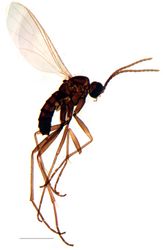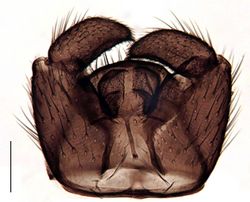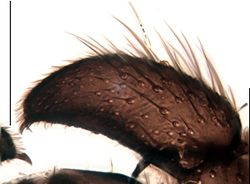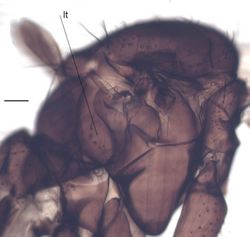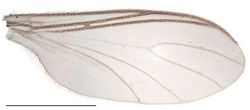Trichosiopsis hispida
Ordo: Diptera
Familia: Sciaridae
Genus: Trichosiopsis
Name
Trichosiopsis hispida (Winnertz, 1871) – Wikispecies link – ZooBank link
Type material
Lectotype ♂, in SDEI, no. 202, bred from pupae collected on April 10th in an old spruce forest on a cow´s den. Paralectotypes: 1♂, 6 ♀♀, several larvae and pupae in SDEI, 1 ♂ in ZMFK.
Type locality
Seesen, Lower Saxony, Germany
Additional material examined
Austria: 1 ♀‡, T, Zillertal Alps, Hornschneide, Lengersdorf (in SDEI); 21 ♂♂†, T, Ötztal Alps, Obergurgl, Rosskar, 21 ♂ ♂, 8.vii-15.viii.1975, Troger (no. 1659-1664 in PWMP); Czech Republic: 4 ♂♂†, B, Kostelni, 19.iv.1988, Barták (no. 1665, 1667, 1669, 1685 in PWMP); 1 ♂, B, Nova Rabyne, 27.iv.1988, Barták (no. 1683 in PWMP); 2 ♂♂, B, Sadská, 3.v.1988, Barták (no. 1670, 1671 in PWMP); 2 ♂♂, B, Spindleruv Mlýn, spruce forest, sweep net, 5.vi.1992, M. Jaschhof (no. 1672, 1684 in PWMP); 1 ♂, M, Horni Lomna, meadow near brook, 20.vi.1986, Barták (no. 1668 in PWMP); Denmark: 1 ♂, Varde, Ho, grey dunes, yellow pan trap, 30.iv.1998, Heller (no. 2632 in PKHH); France: 1 ♂†, 2 ♀♀†, Alpes-Maritimes, Isola 2000, 25.vii.1993, Stark (in SDEI); Germany: 1 ♂†, 1 ♀†, BY, Erlangen, Lengersdorf (in SDEI); 2 ♂♂†, 3♀♀, BB, Britz near Eberswalde, 20.iv.1993, Sommer; 28 ♂♂†, 2 ♀♀†, same data but 22.iv.1993; 1 ♀†, same data but 29.iv.1993; 3 ♂♂†, same data but 6.v.1993; 1 ♂†, 1 ♀† (all in SDEI), BB, Golzow near Eberswalde, 20.iv.1993, Sommer; 1 ♀†, same data but 22.iv.1993 (all in SDEI); 1 ♀†, BB, Klein Ziethen near Eberswalde, 20.iv.1993, Sommer; 4 ♀♀†, same data but 22.iv.1993; 2 ♀♀†, same data but 29.iv.1993 (all in SDEI); 2 ♂♂, SH, Sylt, Braderup, photoeclector, 12.iv.-7.v.1992, Norbert Voigt (no. 524, 525 in PKHH); 7 ♂♂, SN, Chemnitz, Zeisigwald, yellow pan trap, 3.v.2010, Linda Marx (in MNC)[3]; Greece: 1 ♂, Kerkini Mountains, sweep net, 22.iv.2008, Ramel (no. 7003 in PKHH); Italy: 1 ♂†, Adamello Region, 17.vii.1995, Stark (in SDEI); 3 ♂♂, S. Anna de Valdieri, sweep net, 2.vi.1992, Röschmann (no. 1848 in PWMP); Sweden: 1 ♂, Up, Stockholm, Djurgården Park, Malaise trap, 4.-16.v.1994, Heinakroon (no. 359 in NHRS); 1 ♂, same data but 16.-31.v.1994 (no. 580 in NHRS); Switzerland: 1 ♀†, VS, Pic D' Arzinol, 15.vii.1923, Lindner (in SDEI); 1 ♀†, SZ, Steinerberg, v.1950, Lengersdorf (in SDEI).
- † in Mohrig and Menzel (1997: 55)[4] as Leptosciarella trochanterata
- ‡ in Mohrig and Menzel (1997: 63)[4] as Leptosciarella rejecta
Description (male)
Head. Eye bridge 5 rows of facets. LW-index of 4th antennal flagellar segment 2.4–2.6; neck 0.26–0.3 of segment width. Hairs on antennae shorter than segment width. Antennal hairs dense; salient. Thorax. Colour brown. Posterior pronotum setose. Postpronotal setae 4–9; fine. Laterotergite with bristles. 3–5 setae. Legs. Colour yellow-brown, or brown. Hind coxae of same colour as femora, or darkened. Hairs on fore coxae bright. Tibial setae on hind legs normal, shorter than tibial width. Wings. Wing venation weak, with faint m-base, or strong and clearly delimited. Posterior veins with macrotrichia; stM mainly with macrotrichia; cuA1 and cuA2 mainly with macrotrichia; bM bare, or setose; r-m mostly setose; bM:r-M 0.6–0.9; st-Cu:bM 0.6–0.8; r1:r 1.15–1.45; C:w 0.5–0.6. Abdomen. Abdominal setae dorsally white; ventrally white; strong, or weak. Length/Width 0.5–0.6 longer than wide. Gonocoxites broadly separated. Gonostylus 2.25–2.55 × longer than wide; apex tapered. Apical tooth 1.8–2.2 × longer than broad; normal, or weak. Awl-like setae below apical tooth absent. Tegmen 0.6–0.8 × longer than broad; trapezoid or rounded. Measurements. Body size 2.4–3 mm. Wing length 2.5–3 mm.
Etymology
lat. hispidus = rough
Ecology
Not known in detail, mainly found in forests. The type specimens were found as larvae living dispersed in cow dung mixed with litter of spruce (Beling 1886: 7)[5].
Diagnosis
Trichosiopsis hispida is similar to Trichosiopsis trochanterata by the bright hairs on the abdomen and has been considered conspecific by earlier authors (see discussion below). It can be distinguished by most other species of the genus by the presence of setae on the laterotergite. Other characters distinguishing Trichosiopsis hispida from Tr. trochanterata are the entirely bright abdominal hairs, the completely darkened legs with shorter tibial spines, the slightly longer antennae and the more tapered and shorter gonostyli. For distinction with Trichosiopsis coarctata and Trichosiopsis hirsutissima, which also possess a setose laterotergite see under the latter.
DNA Barcoding
The COI sequences are assigned to two different BINs:
- BIN BOLD:ACJ1377 (average distance 0.66%, max. 1.77%, n=13, K2P: 3.86%)
- BIN BOLD:ACO9229 (n=1, K2P: 3.86%)
Discussion
The species concept of Sciara hispida has undergone a lot of changes since the original description. Lengersdorf (1924: 7)[6] was the first one to revise Winnertz´ types. He identified Sciara hispida with Sciara bilineata Staeger, 1840, which is actually considered to be a synonym to Trichosiopsis scutellata (Staeger, 1840). Edwards (1925): 537)[7], who established that synonymy, regarded Sciara hispida consequently again as a distinct species, occurring in two forms, a darker and a brighter one. Lengersdorf (1930: 27)[8] followed Edwards´ view, but in the appendix on page 67 he regarded Lycoria hispida as identical with Sciara trochanterata Zetterstedt, 1851. This confusion arose, because the type series of Sciara trochanterata consists of different species. Consequently the species formerly regarded as Sciara trochanterata (fig. 34) was newly named as Lycoria edwardsi Lengersdorf, 1930. Frey (1948: 74))[9] however did not follow Lengersdorf´s species concept and regarded hispida as being identical to Leptosciara scutellata (Staeger, 1840) sensu Frey, which is Leptosciarella pilosa (Staeger, 1840) sensu Mohrig and Menzel (1997: 73)[4]. In his revision of Finnish Sciaridae Tuomikoski (1960: 25)[10] returned to Edwards´ and Lengersdorf´s concept of Sciara hispida, but disregarding their interpretation of Sciara trochanterata, which he considered to be Trichosia edwardsi (Lengersdorf, 1930). Following the principle of priority he used the older name Leptosciarella coarctata (Winnertz, 1867) and listed Sciara hispida as a synonym. Mohrig and Menzel (1997: 54)[4] reinstated Lengersdorf´s interpretation of Leptosciarella trochanterata, subsuming Leptosciarella coarctata as a synonym but did not do the same with Sciara hispida. Mohrig and Menzel (1997: 54)[4] at last designated the lectotype and listed the name Sciara hispida as synonym of Leptosciarella rejecta (Winnertz, 1867) without further discussion. That synonymy cannot be confirmed by re-examination of the lectotype. Like Edwards (1925), Tuomikoski (1960: 24)[10] had realized, that there are two different forms of his "Trichosia (Leptosciarella) coarctata", a dark legged one with completely bright abdominal hairs and a bright legged one with partially darkened abdominal hairs but he hesitated to regard them as distinct species. Trichosiopsis trochanterata is indeed a complex of different species, but Tr. hispida in the current sense, which has been considered to be part of the dark legged form, can be clearly separated from the former, much more common species, by the setose laterotergite. These setae are a very peculiar character, which was recognized by Tuomikoski[10] (p. 19) in some of the Finnish specimens of Trichosia (Leptosciarella) coarctata. This attribute enables one to identify even females of Leptosciarella hispida reliably. So at least Tuomikoski´s Finnish specimens clearly belong to Le. hispida, whereas the darker British specimens of Le. trochanterata, mentioned by Edwards, still have to be verified. Regarding Lengersdorf (1941: 48)[11] Edwards had already noticed (but not published) the presence of special thoracic setae in Tr. hispida. In that context Lengersdorf identifies Zetterstedt´s specimen from “Toien” [Oslo], later designated as the lectotype of Sciara trochanterata, as hispida. But a re-examination of the lectotype of Tr. trochanterata at the Natural History Museum Lund showed that it is not identical with Tr. hispida.
Distribution
Austria, Belarus, Czech Republic, Denmark, Finland, France, Germany, ?Great Britain, Greece, Italy, Norway[12], Sweden, Switzerland
Subspecies list
Trichosiopsis hispida hispida - Trichosiopsis hispida sellrain
Images
|
References
- ↑ Winnertz, J. 1871: Vierzehn neue Arten der Gattung Sciara. Verhandlungen der kaiserlich-königlichen zoologisch-botanischen Gesellschaft in Wien, 21, 847-860. BHL
- ↑ Heller, K.; Menzel, F. 2011: Ergänzungen und Korrekturen zur Checkliste der Sciaridae (Diptera: Sciaroidea) Schleswig-Holsteins, Deutschland. Studia dipterologica, 17(1-2), 109–112.
- ↑ Marx, L. 2011: Untersuchungen zur Trauermückenfauna des Zeisigwaldes im Stadtgebiet von Chemnitz (Diptera: Sciaridae). Besondere Lernleistung, Museum für Naturkunde, Chemnitz. 23 pp. PDF
- ↑ 4.0 4.1 4.2 4.3 4.4 Mohrig, W.; Menzel, F. 1997: Revision der paläarktischen Arten von Trichosia Winnertz sensu Tuomikoski, 1960 (Diptera, Sciaridae). – Teil II. Gattungen Leptosciarella Tuomikoski, 1960 und Trichodapus gen. nov. Studia dipterologica, 4(1), 41–98.
- ↑ Beling, T. 1886: Beitrag zur Metamorphose der Zweiflügler-Gattung Sciara Meig. (Fortsetzung). Wiener Entomologische Zeitung, 5(3), 93-96.
- ↑ Lengersdorf, F. 1924: Über die Winnertzsche Sciaridensammlung in Bonn. Wiener Entomologische Zeitung, 41(1-3), 6-12. PDF
- ↑ Edwards, F.W. 1925: XXII. British fungus-gnats (Diptera, Mycetophilidae). With a revised generic classification of the family. The Transactions of the Entomological Society of London, 1925(3-4), 505-670. PDF
- ↑ Lengersdorf, F. 1930: 7. Lycoriidae (Sciaridae). In: E. Lindner (Ed.), Die Fliegen der palaearktischen Region (2(1)). E. Schweizerbart’sche Verlagsbuchhandlung, Stuttgart. pp. 1-71.
- ↑ Frey, R. 1948: Entwurf einer neuen Klassifikation der Mückenfamilie Sciaridae (Lycoriidae). II. Die nordeuropäischen Arten. Notulae Entomologicae, 27(2-4), 33-112.
- ↑ 10.0 10.1 10.2 Tuomikoski, R. 1960: Zur Kenntnis der Sciariden (Dipt.) Finnlands. Annales Zoologici Societatis Zoologicae Botanicae Fennicae “Vanamo”, 21, 1–164.
- ↑ Lengersdorf, F. 1941: Bemerkungen zu verschiedenen Sciara- (Lycoria-) Arten. Decheniana. Verhandlungen des Naturhistorischen Vereins der Rheinlande und Westfalens, 100 B, 47-50.
- ↑ GBIF Trichosiopsis hispida
